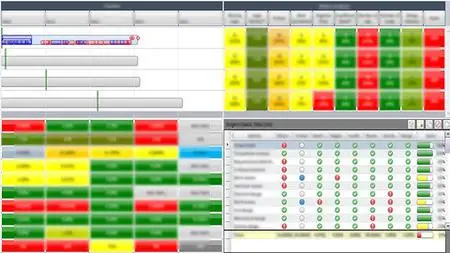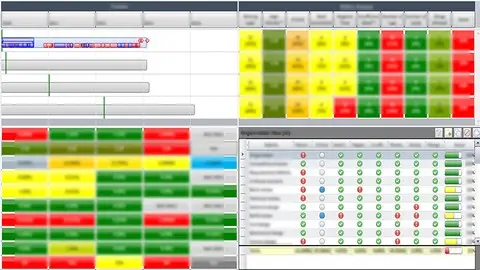Deltek Acumen Fuse - Step By Step
Last updated 7/2020
MP4 | Video: h264, 1280x720 | Audio: AAC, 44.1 KHz
Language: English | Size: 3.09 GB | Duration: 5h 58m
Last updated 7/2020
MP4 | Video: h264, 1280x720 | Audio: AAC, 44.1 KHz
Language: English | Size: 3.09 GB | Duration: 5h 58m
Learn Deltek Acumen Fuse from scratch
What you'll learn
1. Comprehensive Steps to learn and apply Deltek Acumen Fuse Diagnostic Techniques
2. A Brief Overview Acumen Fuse
3. Navigating the Acumen Fuse Workspace
4. Setting up the Acumen Fuse Workbook
5. Viewing, Grouping and Sorting - Activity View
6. Viewing, Grouping and Sorting - SmartGantt View
7. Viewing, Grouping and Sorting - Timeline View
8. Project Scenarios
9. The Schedule Realism Advisor
10. Exercise 1 – Grouping, Sorting and Filtering
11. Navigating the Fuse Diagnostics Window
12. Fuse Diagnostics – Ribbon Analysis
13. Fuse Diagnostics – Phase Analysis
14. Fuse Diagnostics – Intersection Analysis
15. Fuse Diagnostics – Comparison Analysis
16. Fuse Diagnostics – Trend Analysis
17. Fuse Diagnostics – Benchmark Analysis
18. Exercise 2 – Running a Fuse Analysis
19. Understanding and Using the Activity Browser
20. Activity Browser Modes and Views
21. Logic Trace Analysis
22. Adding and Creating Ribbon Views
23. Logic Analysis
24. Forensic Analysis
25. Cleansing the Schedule
26. Dashboard Reporting
27. Publishing and Reporting Results
28. Project Benchmarking
29. Introducing and Understanding Metrics
30. Developing and Managing Basic Metrics
31. Developing and Managing Advanced Metrics
32. Exercise 3 – Creating Metrics
33. Metric Variables, Metric Weighting and Metric Templates
34. Bonus Learning Section
Requirements
A good understanding of Project Scheduling
Deltek Acumen Fuse Software (Trial versions can be obtained from Deltek or your local Deltek software representative
Description
Welcome!This course covers a comprehensive Step by Step approach for learning Deltek Acumen Fuse. The course is extremely detailed and comprehensive, and covers the understanding, use and application of Deltek Acumen Fuse. It is of particular use to all types of enterprises who wish to ensure that their Project Schedules are the best that they can be.The course content applies all versions of Deltek Acumen Fuse.If you are a Project Manager, Project Scheduler, Project Controller, Engineer, Cost Controller, Risk Analyst or anyone else who wishes to learn how to use Deltek Acumen Fuse, then this course is for you. The course is suitable for beginners to advanced users and will be an excellent aid to those users who wish to upgrade or refresh their skills.By the end of the course, you will be able perform Project Schedule Diagnostics and Reporting at a competent level.We will be covering the typical steps required for performing a schedule analysis, using Deltek Acumen Fuse.We will be following the Deltek Acumen S1 to S5 Maturity Framework steps. There are five steps that should be followed to decrease risk, and improve quality and confidence for the validation of Project Schedules.The five steps of the S1 to S5 Maturity Framework are:S1 (the Project Base) – The non -validated scheduleS2 (Critiqued) – the use of schedule diagnostics to identify and correct schedule problems.S3 (Risk Adjusted) – Risk analysis to mitigate identified schedule risks.S4 (Optimised) – Develop cleansed scenarios to accelerate and optimise the schedulesS5 (Team aligned) - Confidence in forecasted dates is improved, and team buy-in on the critiqued, risk-adjusted and optimized schedule is obtained.As a pre-requisite, it is preferable that all participants have a good understanding of the principles of project scheduling.Although it is assumed that imported files will be from Primavera P6, files can also be imported from Primavera Risk Analysis, Microsoft Project, Microsoft Excel, Phoenix Project Manager, Asta Powerproject, UN/CEFACT, Safran or Deltek Open PlanFor many of the participants in this course, it is likely that your organisation will possess licenced copies of Deltek Acumen Fuse for you to use. If you wish to obtain a Trial copy of the software, you will need to contact Deltek or your local Deltek software representative. I have no association with Deltek, so participants themselves will need to ensure that they have a functioning copy of Deltek Acumen Fuse.All of the XER files used in this course can be found in the Samples folder that will have been provided with your copy of Deltek Acumen Fuse.Throughout the course, we will work through examples, followed by exercises to consolidate our knowledge. Answers to the exercises will be provided as we progress and I encourage all students to complete the exercises before moving onto the next lesson.For those students who are interested, there is a fully illustrated Step-by-Step eBook available for this course (591 pages). You'll find full details in the Bonus Learning Section.
Overview
Section 1: Introduction
Lecture 1 Introduction
Lecture 2 A Brief Overview Acumen Fuse
Lecture 3 Navigating the Acumen Fuse Workspace
Lecture 4 Setting up the Acumen Fuse Workbook
Lecture 5 Viewing, Grouping and Sorting - Activity View
Lecture 6 Viewing, Grouping and Sorting - SmartGantt View
Lecture 7 Viewing, Grouping and Sorting - Timeline View
Lecture 8 Project Scenarios
Lecture 9 The Schedule Realism Advisor
Lecture 10 Exercise 1 – Grouping, Sorting and Filtering
Lecture 11 Navigating the Fuse Diagnostics Window
Lecture 12 Fuse Diagnostics – Ribbon Analysis
Lecture 13 Fuse Diagnostics – Phase Analysis
Lecture 14 Fuse Diagnostics – Intersection Analysis
Lecture 15 Fuse Diagnostics – Comparison Analysis
Lecture 16 Fuse Diagnostics – Trend Analysis
Lecture 17 Fuse Diagnostics – Benchmark Analysis
Lecture 18 Exercise 2 – Running a Fuse Analysis
Lecture 19 Understanding and Using the Activity Browser
Lecture 20 Activity Browser Modes and Views
Lecture 21 Logic Trace Analysis
Lecture 22 Adding and Creating Ribbon Views
Lecture 23 Logic Analysis
Lecture 24 Forensic Analysis
Lecture 25 Cleansing the Schedule
Lecture 26 Dashboard Reporting
Lecture 27 Publishing and Reporting Results
Lecture 28 Project Benchmarking
Lecture 29 Introducing and Understanding Metrics
Lecture 30 Developing and Managing Basic Metrics
Lecture 31 Developing and Managing Advanced Metrics
Lecture 32 Exercise 3 – Creating Metrics
Lecture 33 Metric Variables, Metric Weighting and Metric Templates
Lecture 34 Bonus Learning Section
Project Managers, Engineers, Schedulers and Project Controls Personnel



